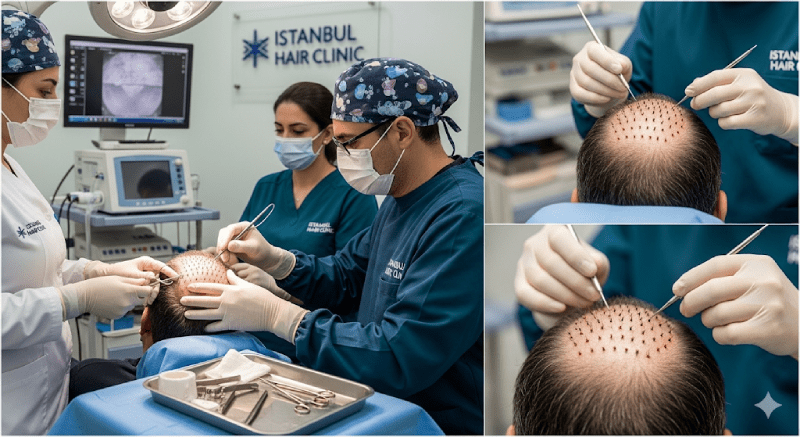Hair loss is a common aesthetic concern affecting both men and women. One of the most effective and permanent solutions to this problem today is hair transplant surgery. Hair transplant technologies are constantly evolving, offering patients different options. The two most popular and frequently applied methods are FUE (Follicular Unit Extraction) and DHI (Direct Hair Implantation) techniques.
Both methods are fundamentally based on the principle of transplanting healthy hair follicles (grafts) from the donor area to balding areas. However, there are significant differences in the application stages, the tools used, and the overall operation process. These differences determine which method is more suitable for a patient’s expectations, the severity of their hair loss, and the surgeon’s expertise.
This article aims to assist individuals considering a hair transplant by delving into the key differences, advantages, disadvantages, recovery processes, and outcomes of the FUE and DHI techniques across 20 subheadings.
FUE and DHI: Basic Definitions
FUE (Follicular Unit Extraction) is a hair transplant technique where hair follicles are individually extracted from the donor area using tools called a micromotor or a manual punch, and then transplanted into channels opened in the recipient area. This method is popular because it is scarless and minimally invasive.
DHI (Direct Hair Implantation), on the other hand, is a technique where both the channel opening and the hair follicle placement are performed simultaneously using a special tool called the Choi Implanter Pen. In DHI, after the hair follicles are extracted from the donor area, they are transplanted directly, minimizing the waiting time outside the body.
The Biggest Difference in the Procedure Process
In the FUE technique, the operation is performed in three stages:
- Harvesting grafts from the donor area.
- Opening channels in the recipient area for the grafts.
- Placing the harvested grafts one by one into the opened channels.
In the DHI technique, this process is completed in two stages:
- Harvesting grafts from the donor area.
- Using the Choi pen to perform the channel opening and hair follicle placement simultaneously.
This fundamental difference directly affects the duration of the operation, the time grafts spend outside the body, and the density of the transplant.
Tools Used: The Choi Pen and the Micromotor
In the FUE method, tools called a micromotor or, more rarely, a manual punch, with tips ranging from 0.6 mm to 1.0 mm in diameter, are generally used to harvest hair follicles. For opening channels in the recipient area, scalpels or sapphire-tipped blades are preferred.
The most distinctive tool of the DHI method is the Choi Implanter Pen. This pen has a thin, hollow needle. The hair follicle is placed inside this needle and directly implanted into the scalp using a plunger mechanism, without the need for pre-opened channels.
The Channel Opening Process
In FUE, small channels (slits) are opened in the scalp before the grafts are transplanted, in a way that is suitable for the hair’s natural exit direction and angle. This step is critically important for the hair to have a natural look after the transplant. It is possible for the scalp to experience micro-level trauma and bleeding during the channel opening.
In DHI, the channel opening process is performed simultaneously with the placement of the graft, thanks to the Choi pen. This leads to less trauma to the scalp because both the channel is opened and the graft is placed in a single motion.
Time Grafts Spend Outside the Body
In the FUE technique, the harvested grafts are kept outside the body in special solutions for a period of time before the transplant begins. This waiting time can bring the risk of grafts losing their viability.
In DHI, hair follicles are transplanted into the recipient area with the Choi pen immediately after they are harvested from the donor area. Since the grafts spend a very short time outside the body during this process, the viability rate of the grafts increases significantly, and the risk of graft loss is minimized.
Transplant Density and Frequency
The DHI method, thanks to the thin tip of the Choi pen, has the advantage of allowing for a denser and more frequent transplant compared to FUE. This ensures a fuller look, especially in areas with thinning hair but not complete baldness.
In FUE, the transplant density depends on the size and frequency of the opened channels. Generally, it is more difficult to achieve a density as high as that achieved with DHI.
Shaving Requirement
In the traditional FUE technique, both the donor area and the recipient area must be completely shaved to allow for easy harvesting of hair follicles and a clear view of the area to be transplanted.
In the DHI method, a complete shave is not always mandatory. If hair loss is concentrated in only a specific area, the transplant can be performed by shaving only the donor area or by partial shaving. This is a significant advantage, especially for female patients or men who want to return to their daily lives quickly.

Recovery Process and Scabbing
After FUE, more scabbing and redness can be observed in the transplanted area due to the opened channels. The recovery period for this scabbing is usually around 10-14 days.
In DHI, since no channels are opened, scabbing and redness are minimal. This accelerates the recovery process and allows the patient to return to their normal life more quickly.
Cost Difference
Generally, the DHI method is more expensive than FUE. The main reasons for this are:
- DHI operations require more care and expertise.
- There is a cost for special and single-use equipment like the Choi pen.
- The operation time can be longer than FUE, which increases the time spent by the surgeon and the team.
FUE has a more standard operation procedure, so it can be offered within a wider price range.
Operation Duration
FUE operations can typically take between 6 and 8 hours. This duration can be longer or shorter depending on the number of grafts.
DHI operations can take longer, as each graft must be individually placed into the Choi pen. An average DHI operation can last between 8 and 10 hours. This can be more tiring for both the patient and the surgeon.
Who Is Each Method More Suitable For?
FUE:
- People with large balding areas.
- Those aiming for overall coverage rather than dense transplantation.
- Individuals with a receding hairline or large areas requiring hair transplant.
- Those with budget constraints, as the cost is lower.
DHI:
- People with thinning hair, but not completely bald, who need transplantation in specific areas.
- Female patients who do not want to shave their hair.
- In cases where transplantation is to be done between existing hairs.
- Those who expect a denser and more frequent result.
Naturalness and Hairline Design
Natural results can be achieved with both techniques, but naturalness largely depends on the surgeon’s experience and artistic ability. DHI can provide a more natural-looking hairline because the hairs can be placed to perfectly match the natural angle and direction.
In FUE, opening the channels at the correct angle is critical. Sapphire-tipped blades can help in more precisely determining this angle.
Graft Harvesting Process
When grafts are harvested with the help of a micromotor in FUE, the surgeon’s experience is crucial to prevent damage to the follicles. This method allows for more grafts to be harvested in a single session.
In DHI, the graft harvesting process is similar to FUE, but after harvesting, the grafts are immediately prepared for transplantation. The absence of waiting time for the grafts outside the body helps preserve the quality of the follicles.
Anesthesia Application
Both operations are performed under local anesthesia. The patient is awake during the procedure and feels no pain.
The Need for a Second Session
Due to the severity of hair loss and genetic predisposition, a second session may be necessary for both methods in some cases. DHI has the potential to give better results in a single session due to a higher graft survival rate, while FUE may require several sessions to cover large areas.
Post-Operative Care Differences
Post-operative care and the first wash are critical after both operations. The recovery process after DHI can be more comfortable as the transplanted area is less sensitive. In FUE, more caution is required due to the channels. In both methods, the patient must strictly follow the care instructions given by the surgeon.
Hair Quality and Thickness
The DHI technique, by minimizing the contact of grafts with the external environment, better preserves the quality of the hair follicles. This can contribute to the growth of stronger and healthier transplanted hair.
Process for Visible Results
In both techniques, a process called “shock loss” occurs within the first few weeks after the transplant. A large portion of the transplanted hair falls out, and new hair begins to grow after 3-4 months. The full results become visible in 12 to 18 months. Since recovery is faster in DHI, this process may start earlier.
Impact on the Donor Area
Both methods do not leave a visible scar on the donor area, but since a larger area is shaved in FUE, it may take longer for the donor area to return to its normal state. In DHI, harvesting follicles from only specific areas ensures the donor area is less affected.
Which Technique Should You Choose?
To choose the right technique, you should first consult a hair transplant specialist to evaluate your hair structure, hair loss condition, and expectations.
- If you want fast recovery and a denser result and your budget allows it, DHI may be more suitable for you.
- If you are planning a comprehensive transplant over a larger area and want to keep the cost more affordable, FUE may be a more logical option.
Remember, both methods yield highly successful results when applied by the right hands. The important thing is to find the one that best suits your personal needs.



